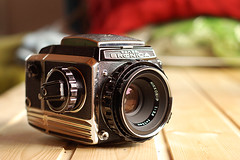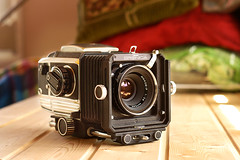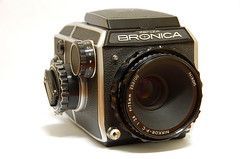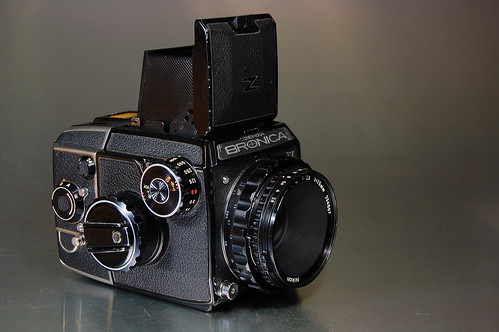Bronica 6×6 focal plane
The first Bronica cameras were a series a 6×6 focal plane shutter SLRs, similar in concept to the Hasselblad 1000F.
Contents
Evolution
Bronica Z / D
The first model is the Bronica Z. It was produced in 1958. It had a number of innovative features that was not available at the time on 6×6 SLR cameras. It was the first with an instant return and downward flipping mirror. Along with a very fast 1/1250th of a second shutter speed.
The main control knob is multi functional and operates the focusing, film advance, and shutter cocking. In normal mode the knob operates focusing. To change to the film advance mode; pull the knob outwards, a red arrow will now show on the knob spindle. Rotate the knob forward to advance and cock the shutter. To return to focusing mode; rotate the knob backwards and it will snap back into place. The shutter settings are also on top face of this same knob.
The shutter settings are from 1 to 1/1250 sec. with X as 1/50 sec for electronic flash sync. B is for the bulb mode and can also be used for exposures from 2 to 10 seconds by using the timer dial. To do so unlock the dial by sliding and holding the lock and rotating the number (2-10)to the red arrow and release the lock when set.
The Bronica D or Bronica Deluxe is a very similar camera to the Z. It was introduced in approx 1960. The new name was created because of the development of the more simplified camera the Bronica S.
Bronica S
The Bronica S introduced in 1961, has new incompatible finders and backs. There were many features no longer on the Bronica S that were available on the previous models including: 2 to 10 sec and 1/1250 shutter speed, self-timer, multiple exposure, focus lock. Improvements include a fool proof dark slide system. The camera will not function properly with a dark slide inserted nor can the back be removed without a dark slide. Dual cable releases are available, one on the shutter button, the other on the bottom base of the camera.
Bronica C
The Bronica C is the corresponding budget version of the S and S2, without the interchangeable back. It was released before the S2, but shares many of the same designs and functions. The Bronica C2 was released a year later, a few months before the S2. The improvements made to the S2 bodys were incorporated into a revised C2.
Bronica S2
The Bronica S2, released in 1965, is the successor of the Bronica S. The new model included a number of minor changes, but the main improvement was the switch to a removable helical focusing mount. This helical mount could focus lenses with focal lengths from 40mm to 200mm; longer lenses had their own helicoids.
Because all of the camera functions are fully mechanical, no batteries are needed to operate it.
The S2 uses a vertical-travelling cloth focal plane shutter. Shutter speeds are available from 1 to 1/1000s and B. Flash sync uses X and FP on an automatic PC terminal at a 1/40s sync speed. The shutter must be cocked before each shot by cranking the film winding lever. The "Filminder" rollfilm back can use 120 or 220 film, selectable with a small dial on the film back. A peel-apart Polaroid back was also available for the S2. Film backs are removed from the camera by inserting a dark slide. As a safety feature, the shutter will not fire if the dark slide is not removed.
The standard lens for the S2 was a 75mm f/2.8 Nikkor P.
The Bronica S2A was released in 1969 and is the successor of the S2. Feature wise it was identical to the S2. The main difference is an improved film advance gear mechanism, reputed to result in fewer jams. Later models changed the camera strap lugs as well as no longer mentioning S2A in the serial number. In the used camera market; this caused some S2A to be sold at lower S2 prices.

|

|

|
|
Bronica S2A with Nikkor P 75mm f2.8 | ||
Bronica EC
The Bronica EC was released in 1972. It has an electronically controlled shutter, and the Bronica EC-TL adds a TTL exposure meter.

|
| Bronica EC image by Luciano Lazzarotto (Image rights) |
Specifications

|
| Bronica S2 image by Howard Somerville (Image rights) |
| Z / D | S | S2 | C / C2 | ||
|---|---|---|---|---|---|
| Introduction | 1959 | 1961 | 1965 | 1964 / 1965 | |
| Type | 2 1/4 x 2 1/4 (6cm × 6cm) Single lens reflex camera | ||||
| Film back | removable | integrated w/ film magazines | |||
| Film | 120 roll film 12 exposures |
120/220 roll film 12/24 exposures | |||
| Finder | Fresnel lens and large magnifier | ||||
| Viewfinder hood | interchangeable with pentaprism finder or magnifying hood | ||||
| Focusing | Removable, Helicoid type, stroke 14mm, rotating angle of focusing ring 250 degrees | ||||
| Distance Scale | 75mm, 50mm, 135mm lenses | 75mm, 50mm, 135mm, and 200mm lenses | |||
| Mirror | flip down, instant return, automatic mirror system | ||||
| Diaphragm | Auto: 75mm, 50mm, 135mm lenses | Auto: 75mm, 50mm, 135mm, 200mm and 400mm lenses | |||
| Depth-of-Field | Depth-of-field can be checked by pressing preview button | ||||
| Shutter | Vertical-travel focal plane shutter | ||||
| Shutter Speeds | B, 1, 1/2, 1/4, 1/8, 1/15, 1/30, 1/60, 1/125, 1/250, 1/500, 1/1250, X (1/50) Long exposure: 1s to 10s |
B, 1, 1/2, 1/4, 1/8, 1/15, 1/30, 1/60, 1/125, 1/250, 1/500, 1/1000 and 'X' (1/50) |
B, 1, 1/2, 1/4, 1/8, 1/15, 1/30, 1/60, 1/125, 1/500, 1/1000 and 'X' (1/40) | B, 1, 1/2, 1/4, 1/8, 1/15, 1/30, 1/60, 1/125, 1/500, 1/1000 and 'X' (1/40) (not all models have 1/1000) | |
| Multiple exposure | yes | X | via multi exposure knob | ||
| Self timer | yes, adjustable delay 1 to 10s | X | X | ||
| Film winding | winding crank or knob | ||||
| Dimensions | 89 × 86 × 136 | 100mm × 100mm × 140mm | |||
| Weight | 1.165 kg | 1.790 kg | 1.780 kg | ||
Bibliography
- Asahi Camera (アサヒカメラ) editorial staff. Shōwa 10–40nen kōkoku ni miru kokusan kamera no rekishi (昭和10–40年広告にみる国産カメラの歴史, Japanese camera history as seen in advertisements, 1935–1965). Tokyo: Asahi Shinbunsha, 1994. ISBN 4-02-330312-7. Items 1513–7. (See also the picture on p.22.)
- Lewis, Gordon, ed. The History of the Japanese Camera. Rochester, N.Y.: George Eastman House, International Museum of Photography & Film, 1991. ISBN 0-935398-17-1 (paper), 0-935398-16-3 (hard). Pp.102–3, 138 and 147.
- McKeown, James M. and Joan C. McKeown's Price Guide to Antique and Classic Cameras, 12th Edition, 2005-2006. USA, Centennial Photo Service, 2004. ISBN 0-931838-40-1 (hardcover). ISBN 0-931838-41-X (softcover). Pp.159–62.
- Sugiyama, Kōichi (杉山浩一); Naoi, Hiroaki (直井浩明); Bullock, John R. The Collector's Guide to Japanese Cameras. 国産カメラ図鑑 (Kokusan kamera zukan). Tokyo: Asahi Sonorama, 1985. ISBN 4-257-03187-5. Items 2071–4.
Links
General links
In English:
- Bronica Users Group (BUG) at the Yahoo Groups site
- Bronica pages at medfmt
- Bronica D, Bronica S, Bronica EC and Bronica EC-TL at Cameraquest
- Bronica focal-plane cameras at Nikkor lenses for medium format cameras by Hiura Shinsaku
- Bronica S2 at Cosmonet's Classic Camera website
- Bronica Identification and Features at www.craigcamera.com
In French:
In Japanese:
- Bronica focal-plane cameras and lenses at Hiura Shinsaku's camera site
- Bronica Deluxe and more pictures at Hayata Camera Laboratory
- Bronica S and Bronica EC at Asacame
Sample pictures
Documentation and user manuals
- Bronica S2 sales brochure (#BR-302) at medfmt, provided by Bill Barton
- Bronica S2A manual at medfmt, provided by Mike Bond
